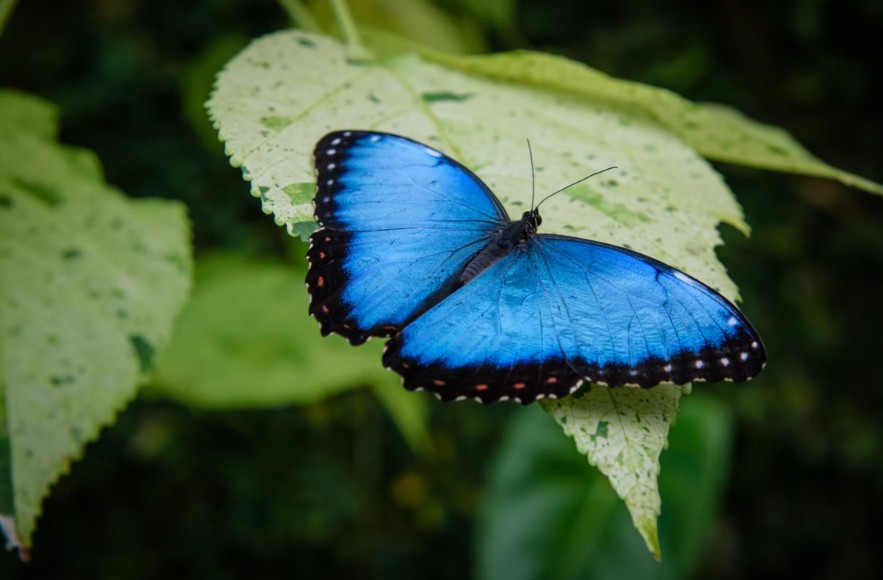
Blue Butterfly : Complete Guide 2024(Update)
Introduction
The blue butterfly is one of the most beautiful creatures on earth, and it can be found in many locations around the world. The blue butterfly has a wingspan of about 4 inches and features bright blue coloring and black spots.
Usually brightly coloured with patterns on them. The Blue Butterfly is one of the most common butterflies found throughout the world. They are particularly common in America, Australia, South Africa and Europe. There are many different types of butterflies that come in all shapes, sizes and colours but none can compare to the Blue Butterfly !
This guide will help you learn more about this fascinating insect so you can enjoy it for yourself!
Where Does Their Name Come From?
The name blue butterfly comes from the Latin word “cyanus,” which means “dark blue.” But, this is not just any dark blue; it’s the darkest of all blues. In fact, calling these butterflies “blue” is a bit misleading because they’re actually even darker than that!
In addition to being called blue butterflies by many people who aren’t as familiar with Latin or Greek as they are with English, this species also has other nicknames. You may have heard them referred to as brown or grayish-black butterflies before. However, their true coloration can best be described by using words like blackish or dark grayish-black instead of brown (if you want something more specific).
Blue Butterfly Scientific Name
The blue butterfly’s scientific name is Polyommatus icarus. This name was given by Louis Ernest Boisduval, a French entomologist who discovered the butterfly in 1832 and named it after Icarus, a character from Greek mythology who flew too close to the sun and fell into the sea.
Polyommatus icarus comes from the Greek language, where “poly” means “many,” “omma” means “egg,” and “tatus” means “to have or possess.” So polyommatus icarus really just means “many-eyed egg-possessor.”
How To Identify A Blue Butterfly?
The blue butterfly, also known as the eastern swallowtail or tailed jay, is a large species of butterfly that is commonly found throughout much of North America. They are one of the most common butterflies in this region and are easily identified by their bright blue wings.
Blue butterflies belong to the genus Papilio as well as other genera such as Pachliopta and Cynthia (the latter being a subgenus).
In order to identify a blue butterfly, you can look for some specific features. They have bright blue wings with black bands at the base of each one. The butterfly’s body is dark gray and covered in yellow spots.
Types Of Blue Butterflies
The blue butterfly is a common name for a large number of butterflies, which are found in many parts of the world. Blue butterflies are also known as hairstreaks or azure-winged butterflies (genus Hairstreak).
Blue butterflies do not have any particular scientific classification, but they can be divided into two broad categories:
- The first group includes those that belong to the Lycaenidae family. They are small and colorful insects with wings generally less than 2 inches long. These insects range in size and color from bright green to deep purple-black depending on their species and location within their habitat (for example, mountain ranges).
- The second group is made up of butterflies in the genus Celastrina, which is a large genus of blue butterflies native to North America. They are generally small and delicate insects with wings that range from 1.5 inches to 2.25 inches long.
What Does A blue Butterfly Eat?
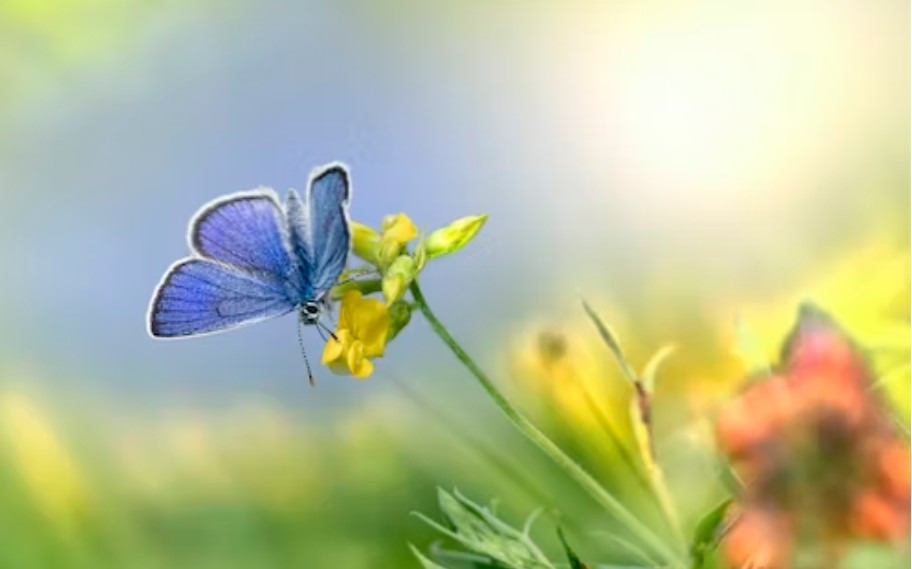
You’re probably wondering what a blue butterfly eats, and the answer is pretty simple: nectar from flowers. A blue butterfly also eats pollen and honeydew, which are both sugary foods that can be found on flowers.
Blue butterflies also eat fruit, sap from trees (such as maple trees), and leaves of plants.
Blue Butterfly Habitat and Range
Blue butterflies are found in temperate areas of the Northern Hemisphere. They live in North America, Europe, and Asia. Their habitat can be found throughout the United States, Canada, and Mexico—as well as parts of Europe.
Blue butterflies prefer to live near open fields where there are lots of flowers for them to feed on. They like sunny spots because they’re diurnal (active during the day).
Blue Butterfly Physical Characteristics
The blue butterfly is a medium-sized butterfly, with a wingspan of 1.5 to 2 inches (3.8 to 5 cm). The blue morpho has a wingspan of 6 to 1.5 inches (15 to 3.8 cm), while the common morpho can have a wingspan of 4 to 6 inches (10 to 15 cm).
Blue Butterfly Diet
The Blue Butterfly diet is a little more complex than the Monarch and Pipevine Swallowtail diets, but not by much. The main difference between these butterflies is that they eat different nectar and have different host plants than the other two species.
The Blue Butterfly has several host plants that it uses during its larval stage, including Lantana camara, as well as wildflowers such as Verbena (Verbena spp.), Vinca (Vinca spp.), and Veronicastrum virginicum. When they are in their adult stage, they will feed on nectar from flowers and shrubs like lantana (Lantana camara), vinca (Vinca major), verbena (Verbena officinalis) or vetiver grasses depending on where they live!
The Blue Butterfly is also unique because of how it obtains its food. Unlike other butterflies, which obtain their nourishment through the process of sucking up nectar from flowers and leaves, the Blue Butterfly obtains all of its nutrients by boring holes in plants with its proboscis.
Blue Butterfly Behavior
Blue butterflies are diurnal, meaning they are active during the daytime. They spend their days flitting around and collecting nectar from flowers. If you see a blue butterfly flying at night, it could be one of their close relatives such as the tropical admiral or the western tailed blue — both of which are also diurnal.
Blue butterflies are social animals that live in large groups called colonies. These colonies can number in the hundreds of thousands! Some species even form harems with one male and several females sharing a territory together (which is rare among butterflies). The group is usually led by an alpha female who protects her offspring and mates within her colony.
Blue Butterfly Predators and Threats
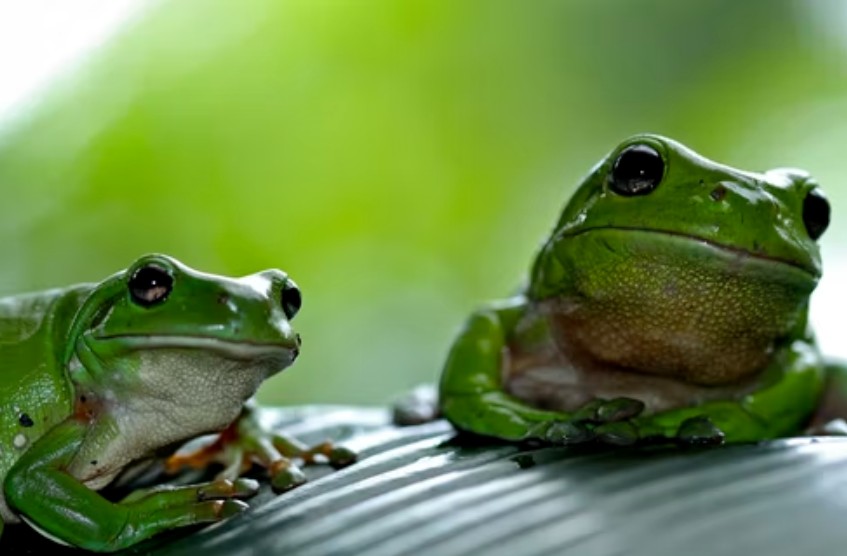
Blue butterflies are preyed upon by birds, lizards, and other insects. They are also threatened by habitat destruction, pollution and climate change. In addition to this, blue butterfly populations are at risk from their food sources being destroyed as well as their habitat being destroyed.
Blue Butterfly Life Cycle
The blue butterfly life cycle can be broken down into 4 stages: egg, larva (caterpillar), pupa (chrysalis) and adult.
The blue butterfly eggs are laid on the food plant of their species. They hatch after several days but do not become caterpillars immediately because they must go through a series of molts to reach full growth. Each time a caterpillar molts it will grow larger in size and shed its exoskeleton as it increases in size. After several months or sometimes years depending on the species, the larva will enter a cocoon where it will continue to mature for about two weeks until emerging as an adult ready to mate and lay its own eggs!
Blue Butterfly Lifespan And Reproductive Habits
Blue butterfly larvae are green with black spots, and their heads are red-orange. They undergo five molts before becoming pupae. The last two instars are called “pupae,” but they’re still larvae that haven’t yet formed into adults.
The larval stage lasts about 2 to 3 weeks, depending on the temperature and food availability for each species of blue butterfly. Once it’s ready to develop into an adult, it digs itself out of its cocoon (or pupal case) and expands its wings in order to dry them off before flying off into the great beyond.
- In reality, these butterflies don’t have any idea where they’re going—they just fly around looking for places that are warm enough to stay alive until winter comes along again!
The 9 Prettiest Blue Butterflies In The World.
Blue butterflies are some of the most beautiful butterflies in the world. They come in a wide variety of colors, and are found on every continent except for Antarctica. There are more than 6,000 different species of blue butterfly in the world, and each one is unique.we found the 9 prettiest blue butterflies in the world.
Adonis Blue
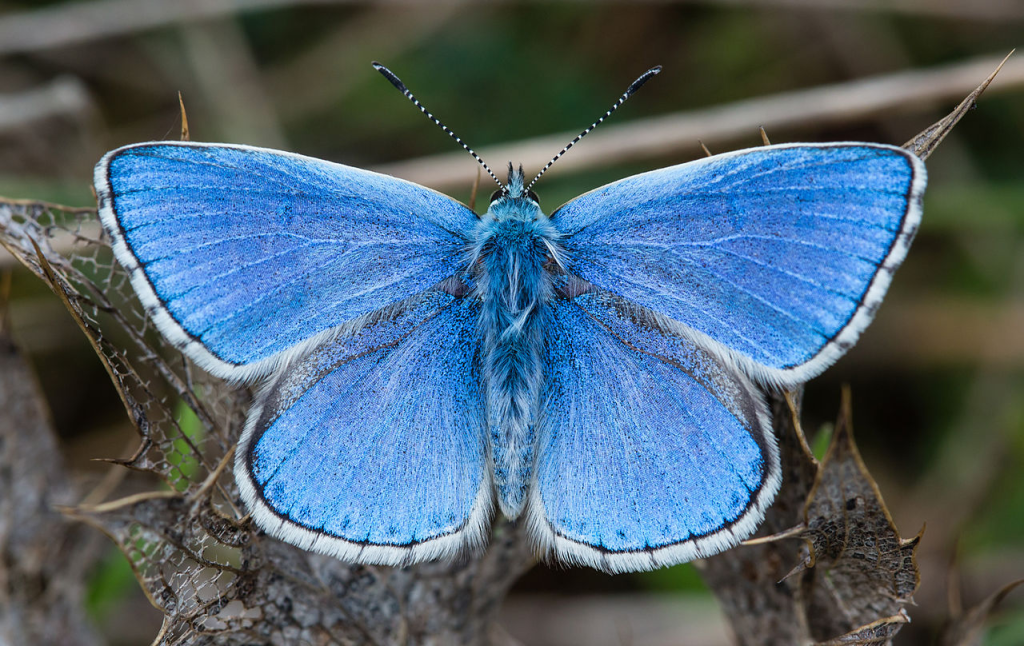
Adonis Blue butterfly, Polyommatus bellargus, is a large and common butterfly of the family Lycaenidae. It is found in Europe and Asia Minor. The butterfly ranges from northern Spain to Japan and south to North Africa and Central Asia. A subspecies is found in the Caucasus region.
It can be identified by its bright blue wings with black spots on them, which are edged with white. The male Adonis Blue has dark brown eyes; the female’s eyes are brown or orange-brown. The wingspan of this species is between 28 and 40 millimetres (1 1⁄2 and 15⁄16 inches). Adults normally fly from June until September depending on location, but they may remain on the wing all year round in warmer regions such as southern Europe.
Adults usually mate once before dying; males do not feed after mating. They lay their eggs on grasses and low-growing plants such as chickweed (Stellaria media) or thistles (Carduus spp.). The caterpillars live for about two weeks, during which time they will eat their host plant completely through before pupating within it.
Chalk Hill Blue
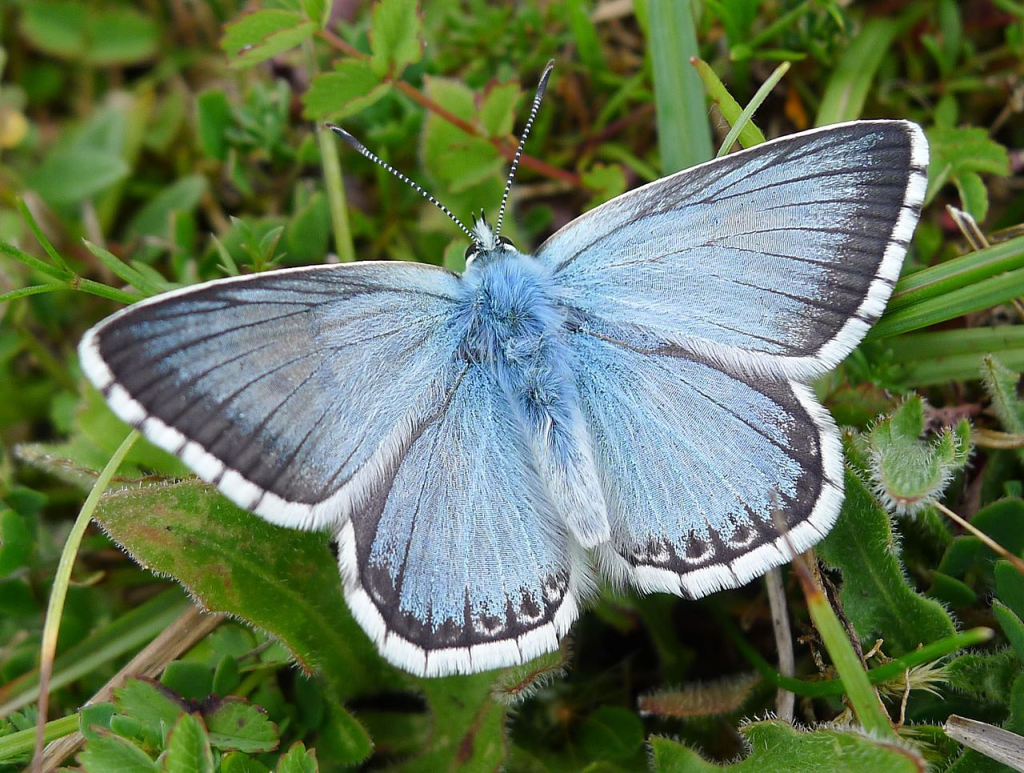
Chalk Hill Blue butterfly (Celastrina argiolus) is a butterfly of the family Lycaenidae. It is found in Europe and North America.
Chalk Hill Blue butterfly (Celastrina argiolus) is a butterfly found in India and Sri Lanka. It belongs to the family of Lycaenidae and is commonly known as the Blue-banded Peacock or the Blue Peacock.
It is a small butterfly with a wingspan of only 2 inches (50 mm). The upper side of the wings are dark blue with an oblique white line across each wing and two vertical white lines on the hindwings. The underside of the wings are pale brownish with dark brown spots on them. This species can be distinguished from other blue butterflies by its characteristic white bands on both pairs of wings.
The Chalk Hill Blue lives in moist lowland forests and marshy habitats up to an altitude of 1,500 feet (450 m) above sea level. In Sri Lanka this butterfly is found in wet montane grasslands from sea level up to 1,500 feet (450 m). In India it is found at heights between 250-1,800 meters above mean sea level (AMSL) but mostly below 500 meters AMSL.
Common Blue
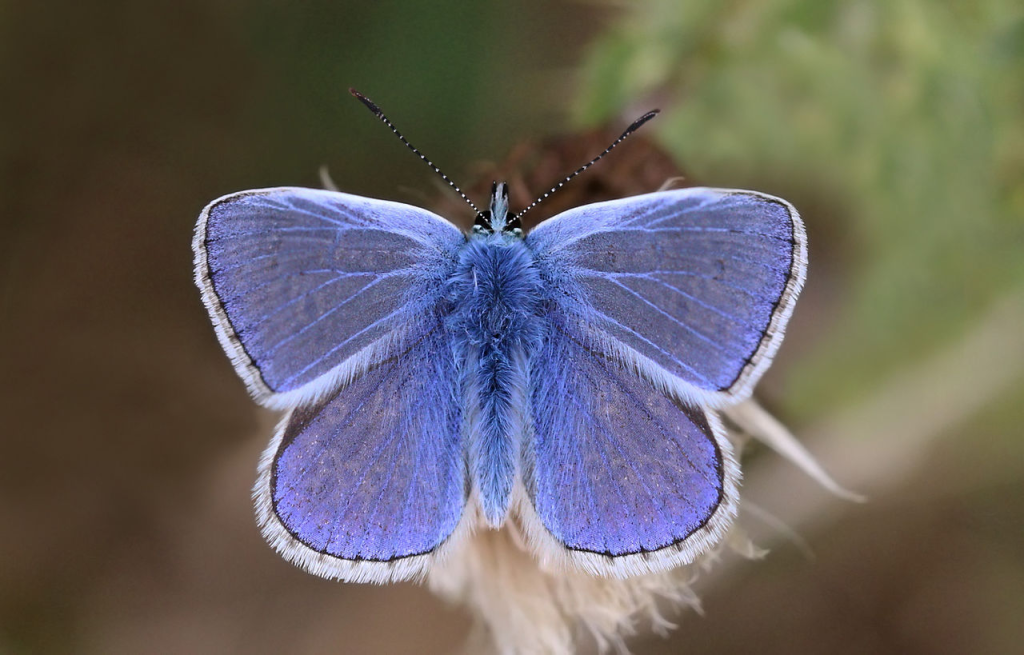
Common Blue is a butterfly of the family Lycaenidae. It is found in Europe and North Africa.
Common Blue is a small butterfly, with a wingspan of 22–27 mm. The upperside of its wings are dark brown, with an orange/yellow margin that has black spots on it for camouflage when it’s sitting on flowers. The underside of their wing is light greyish-brown in color with darker spots at the ends of their main veins, which helps them blend into flower petals.
Holly Blue
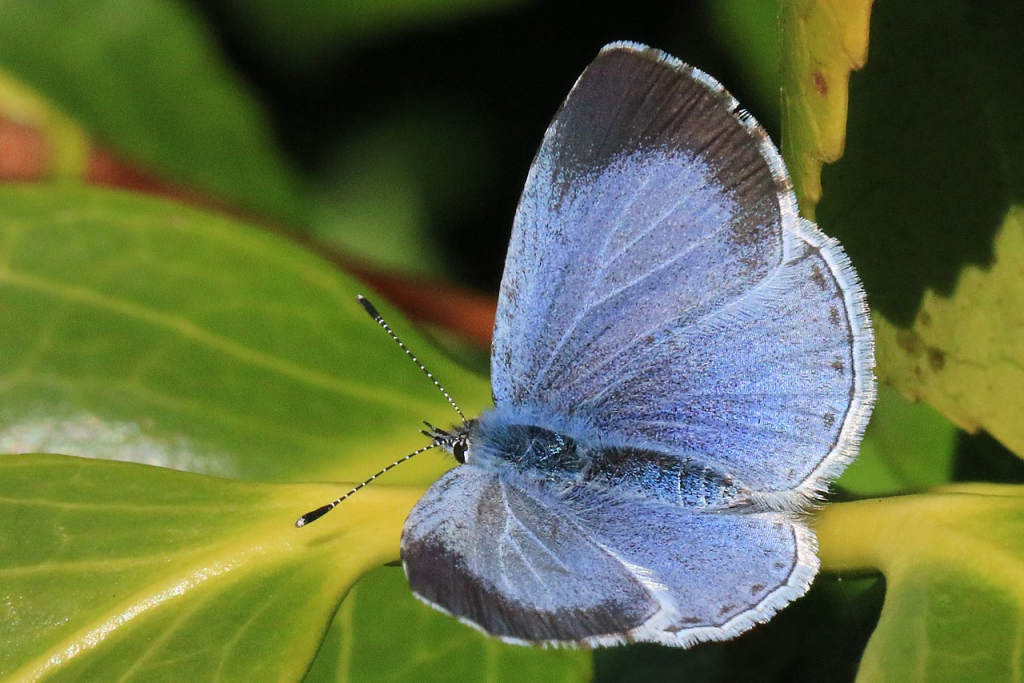
The Holly Blue butterfly is one of the most common butterflies found in Britain. It is often seen fluttering around gardens, woodland edges and meadows. Its caterpillars feed on a number of plants, including bedstraws, honeysuckles and elderberries.
The Holly Blue is a smallish butterfly with a wingspan of around 35mm. It has a dark brown or blackish background colour with a row of pale markings along each wing tip. The inner edge of each forewing has a single blue spot, which gives this species its name. The undersides are duller than the uppersides but still have some blue spots on them. Males are slightly smaller than females; they also have slightly fewer spots on their wings than females do.
Common Grass-Blue

Common Grass Blue is a medium-sized butterfly, with wingspans of around 45-65mm. It is a member of the lycaenid family and can be found in Europe, Asia and North Africa. The butterfly is found in the Palearctic ecozone which includes Europe, northern Asia and northern Africa.
The butterfly is found in a wide range of habitats, including meadows, fields and gardens. It can also be found in urban areas where there are small patches of green space.
The Emperor
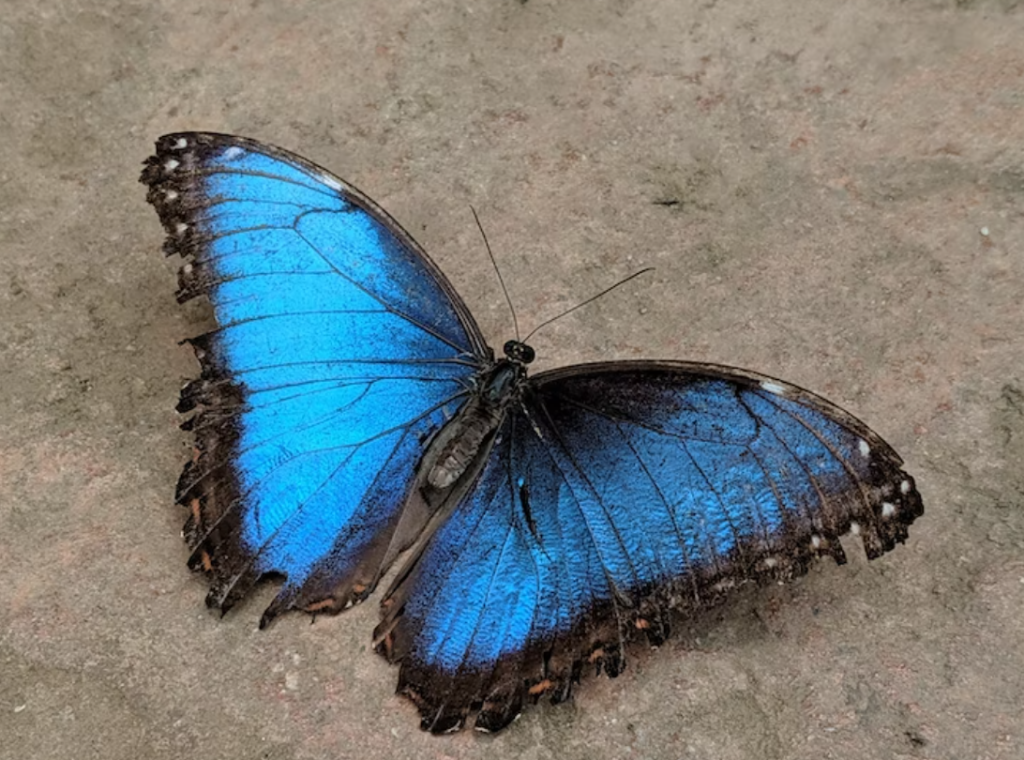
The Emperor is a large butterfly with a wingspan of up to 5.5 inches. Its body is blue-black with white spots, and its wingtips are orange. The female Emperor is brown with darker spots and orange wingtips.
In flight, Emperors are fast and strong flyers that spend most of their time in the open, unlike many other butterflies which prefer shade or vegetation for protection from predators (like birds!).
The Emperor has a lifespan of up to five months!
Palos Verdes Blue

The Palos Verdes Blue butterfly is a subspecies of the western blue butterfly (Maculinea arion). It is endemic to Point Vicente in Palos Verdes, California. The population has been declining since its discovery in 1984 and was listed as an endangered species by the United States Fish and Wildlife Service in 1997.
The Palos Verdes Blue butterfly is a small butterfly with a wingspan of 1 to 1.5 inches (2.5 to 4 cm). The forewings are dark gray with a blue sheen; the hindwings are gray with brown spots along the outer edge that resemble eyespots. The female butterfly lays eggs on purple sand verbena (Abronia latifolia), which grows near the shoreline, especially on sand dunes near the ocean. The larva feeds on this plant while it develops into a pupa before emerging as an adult butterfly.
The Palos Verdes Blue butterfly lives only in Point Vicente State Park at the tip of the Palos Verdes Peninsula in Los Angeles County, California. As of 2004, there were only about 100 individuals left in existence.
Dark Grass Blue

The Dark Grass Blue is a small butterfly with a wingspan of approximately 1.5 inches and can be difficult to see due to its dark coloration. It is most often found in the eastern United States, but has also been seen in parts of Mexico, Central America, and South America.
Dark Grass Blues are very fast fliers and can fly over great distances at high speeds, which makes them challenging to photograph as they move so quickly that you must take quick action when photographing them or else they will disappear before you have time enough to adjust your settings on your camera.
Lesser Grass Blue
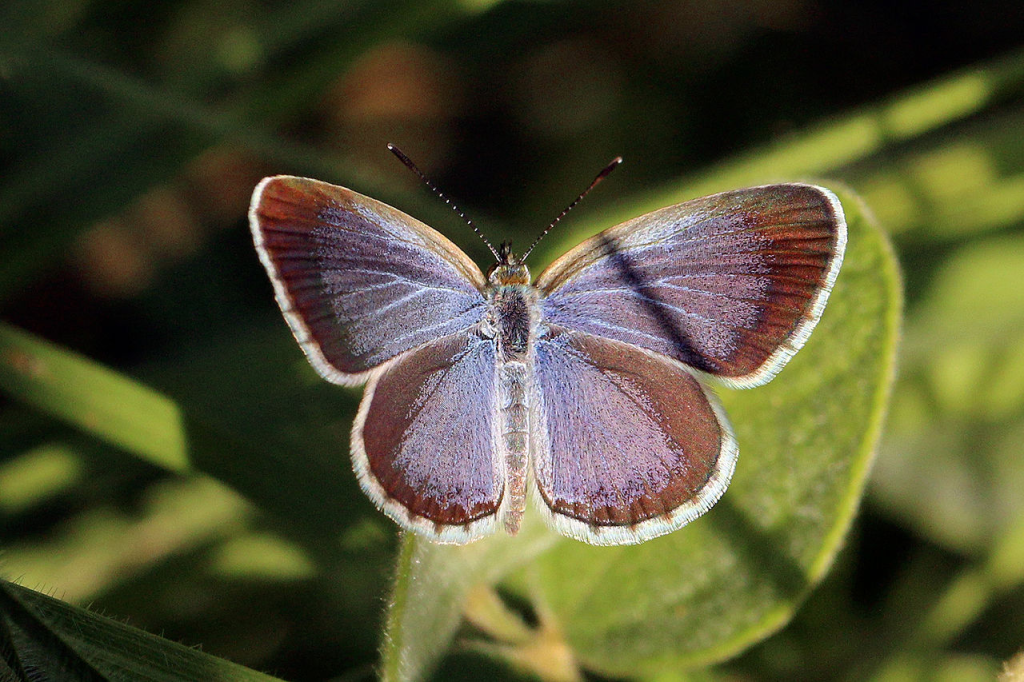
The lesser grass blue is a small butterfly with a wingspan of between 22 and 26 millimetres. The butterfly can be found in Europe, Asia and North Africa, where it prefers to live near meadows, grasslands and roadsides.
The lesser grass blue is a butterfly that prefers to live in places with plenty of sunshine and open grassland. It’s common for them to be found near meadows and roadsides, where they can lay their eggs on the leaves of plants such as clovers and trefoils.
5 Most Beautiful Blue Butterfly In The World.
Pipevine Swallowtail

The Pipevine Swallowtail is a large butterfly native to the United States. It’s also known as black swallowtail and black papilio. The Pipevine Swallowtail has a wingspan of about 6 inches, making it one of the largest butterflies in North America.
This butterfly is bright green with dark brown spots on its wings, which are covered in large eyespots that resemble eyes (hence the name “swallowtail). The edges of its wings are also fringed with black or white hairs called “tails”—hence why they are sometimes called swallowtails!
Large Blue

The Large Blue is a common butterfly of Europe, North Africa and Asia. It has a wingspan of up to 5 inches (12 cm), and its upperwings are dark brown with a blue sheen. It is also sometimes known as the Dark Hairstreak or Large Copper, after which it was named in 1758 by Carl Linnaeus.
The Large Blue is closely related to the Small Blue but can be distinguished by its larger size, more pronounced black markings on the underside of its hindwings (the part that faces away from you when perched), and generally being deeper in colour than its smaller cousin. Some authorities consider them distinct species; others treat them as subspecies or even varieties of each other
Morpho Menelaus

Morpho Menelaus butterfly is a common species of butterfly found in the tropical Americas. It is native to Central America and northern South America, but its range extends into southern North America and the Caribbean. Morpho Menelaus butterflies are almost always seen in pairs.
Morpho Menelaus butterfly is one of the most popularly sought after species of butterflies in the world. It is known for its beautiful colors and large size. The wingspan of Morpho Menelaus butterfly ranges from 6 inches to 8 inches. This makes it one of the largest butterflies in the world. The butterflies also have a long lifespan and can live up to six months or more in captivity.
The coloration of Morpho Menelaus butterfly varies depending on where it is found and what season it is in. In general, though, these butterflies have a wide variety of bright colors that include blue, green, yellow and red among others. These bright colors make them very attractive to both humans as well as predators who would like nothing more than to eat them up!
African Moon Moth

The African moon moth, which can be found in Africa, is one of the largest blue butterflies in the world. With a wingspan of up to 7.5 inches and bright orange eyespots near its wing tips, this butterfly looks like it might be part moth! It has been observed as far north as southern France and Spain.
This species tends to lay its eggs on plants that are already infested with caterpillars or moths—so if you see them flying around your garden regularly, it may be time for some pest control measures!
Sliver Blue Butterfly

The Sliver Blue Butterfly is a small, bright blue butterfly found in the southeastern United States. It is the smallest of the blue butterflies and has a wingspan of just 2 1/2 inches.
The silver blue butterfly is most often seen flying around flowers in open areas including meadows, fields and pastures. It can also be found in parks and gardens if there are flowers for them to feed on.
Blue Butterfly Meaning
Blue butterflies are a symbol of happiness, good fortune and success. It is believed that seeing a blue butterfly will bring you health, love and peace. It is also used to protect against evil spirits. Blue butterflies symbolize the highest form of happiness and good fortune as they carry it with them wherever they go!
Blue Butterfly In Different Cultures
Blue butterfly can be found in the Okinawa and Kyushu regions. It was believed that this insect was an auspicious symbol and that it had healing powers. In ancient times, people would drink from a cup made from a blue butterfly’s wing which they believed would help their illness go away. They also thought that if you wore one on your kimono, you were protected from misfortune, disease and evil spirits!
In China, blue butterflies were symbolized by royalty and wealth because of their beautiful color and rarity. They were considered sacred creatures who brought luck when seen flying through the air or perched on flowers during springtime (the time of year when they mate). If you ever find one dead on your property then it means good fortune will come soon!
Blue butterflies are very popular in Thailand. They are known as “Pai-Nong” which means “Flower of Heaven” or “Angel Wings” and they symbolize good luck. She also is believed to be the reincarnation of a beautiful woman who died at sea while trying to escape from pirates with her fiancé.
In Indonesia, the blue butterfly is a symbol of good luck and happiness. In Korea it’s representative of children’s innocence because they don’t know where they came from or who gave birth to them so their souls are still pure and innocent. The blue butterfly was also known as “The Bird of Paradise” by European sailor explorers who encountered these animals on their travels through tropical regions.
Dreaming Blue Butterfly Meaning
In the world of spirituality and mythology, the blue butterfly is a symbol of transformation. The blue butterfly is also known as the “Dream Butterfly” because it represents creativity and imagination. The color blue itself has many meanings that may help explain why this unique insect is so important in spiritual traditions around the world.
Blue is associated with wisdom, knowledge, truth and trustworthiness; it’s also linked to loyalty, justice and clarity. In China blue symbolizes happiness while in Japan it’s considered an unlucky color due to its ties with death (butterflies are commonly used at funerals). If you’re looking for ways to incorporate more blues into your life—and who isn’t?—here are some ways you can do so:
- Wear a pair of light-blue jeans when you’re going somewhere special like on a date night or out on the town with friends!
- Paint your room sky-blue so that when you wake up every morning there will always be hope shining down upon you from above–or at least through your windowpane!
Where is Blue Butterfly Found
Blue butterfly is found in the tropics, southern hemisphere, northern hemisphere, eastern hemisphere and western hemisphere. It can also be found at the middle of our earth.
Blue Butterfly Jewelry
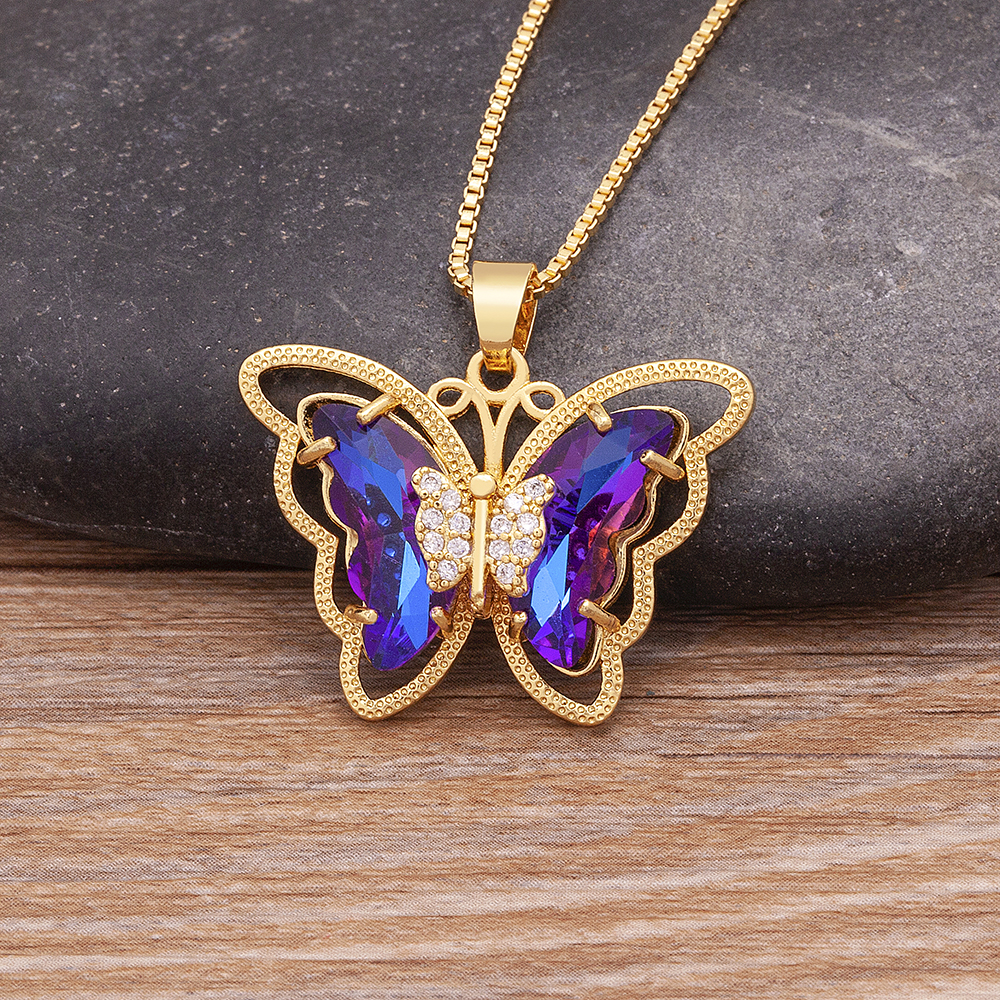
As a symbol of luck and fortune, blue butterfly jewelry is a popular choice for both men and women. Blue butterflies are also popular for children, making them an excellent choice for a gift.
For those who want to add some fun and sparkle to their wardrobe, blue butterfly earrings are the perfect option. They come in many different styles from simple studs to intricate dangling designs. For those who prefer a more traditional look, there are also many beautiful necklaces available in this color scheme that will complement your outfit perfectly!
Wearing Blue Butterfly Jewelry Benefits
Blue butterfly jewelry is a beautiful way to connect with the spiritual realm and your inner self. By wearing blue butterfly jewelry, you can feel more connected to yourself, others and the universe.
Protects From Negative Energy

The blue butterfly is believed to protect from negative energy and evil spirits. It also helps in healing emotional problems and promotes positive thinking. The blue butterfly symbolizes immortality, resurrection, rebirth and reincarnation.
Harmful Effects Of Toxic People On Your Health
Wear blue butterfly jewelry to protect yourself from toxic people who have a negative impact on your mental well-being and health. The negative energy of these people can cause depression, anxiety, nervousness, headache or other physical ailments in your body. Wear this jewelry to stay safe from such people and enjoy a trouble-free life.
Conclusion
The blue butterfly is one of the most recognizable and beautiful insects on earth. They have a variety of different colors, but they all have blue wings with black spots on them. There are several different types of blue butterflies that live in different parts of the world so it can be hard to tell them apart unless you know what type there are. The most common type is known as ‘butterfly’ which lives in North America and Europe.
If you have read over this article, so it indicates that you have some concerns about blue butterfly jewelry .No body likes to be troubled with their fashion accessory, this is especially true if a person is not completely satisfied with what they are wearing.Here we introduce our Charming Four Butterfly Pendant Necklaces ,we give 8 reasons why you should wear it.
You want to look unique, but with such a variety of choices it can be hard to discern an individual and timeless piece of butter fly jewelry from cheap mass-produced imitations,you should try Vintage Butterfly Love Heart Necklace.
Did You Enjoy This Article?
Thank you for reading this article. If you enjoyed i, you might also like the following articles:
Why You Should Get a Butterfly Necklace 10 Ways to Get Lucky With a Butterfly Necklace